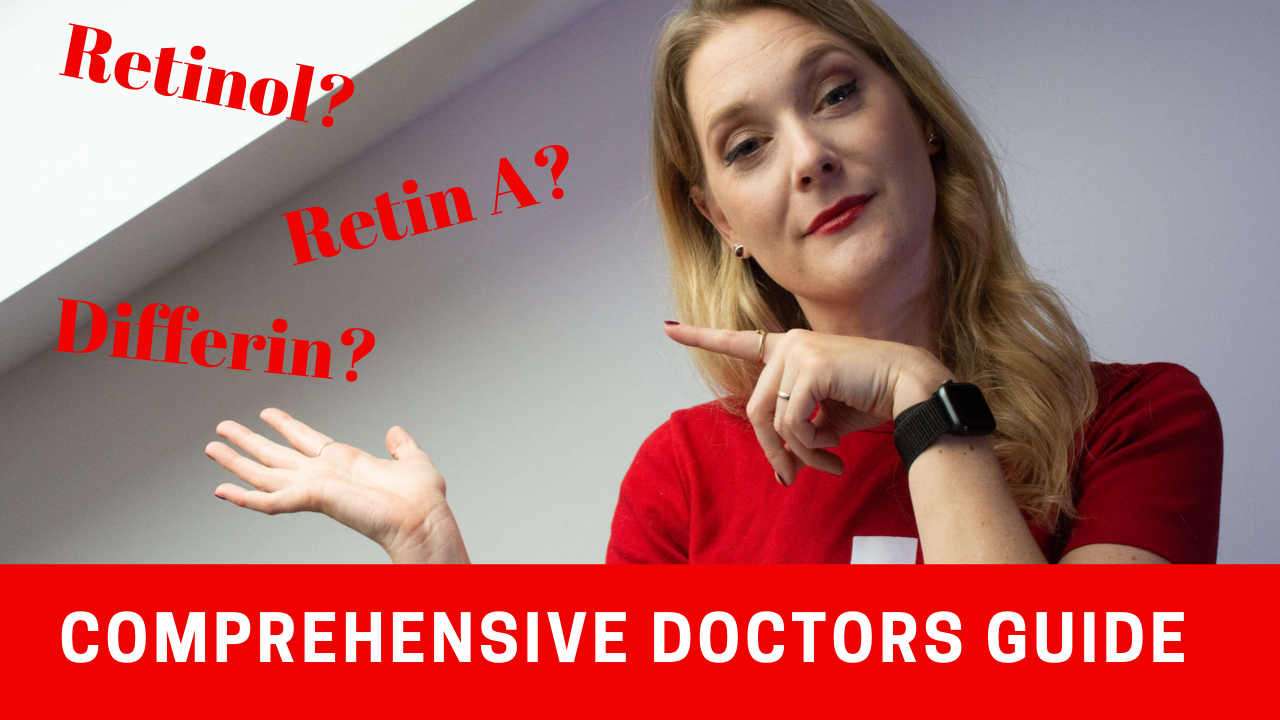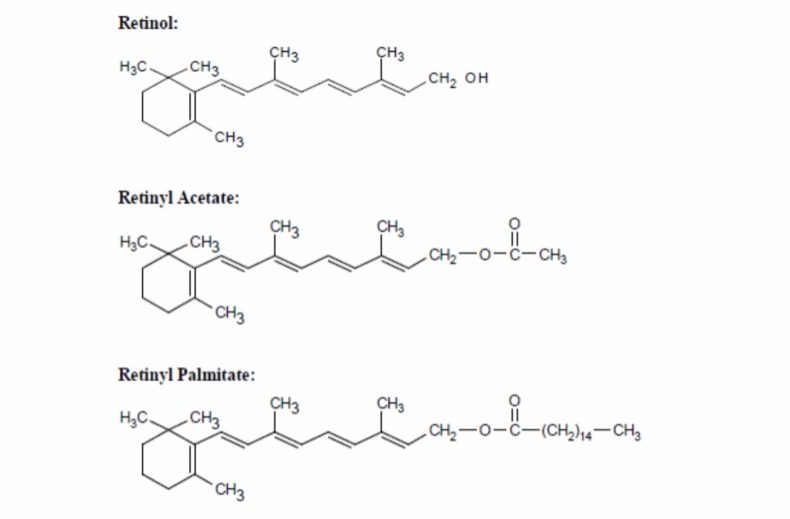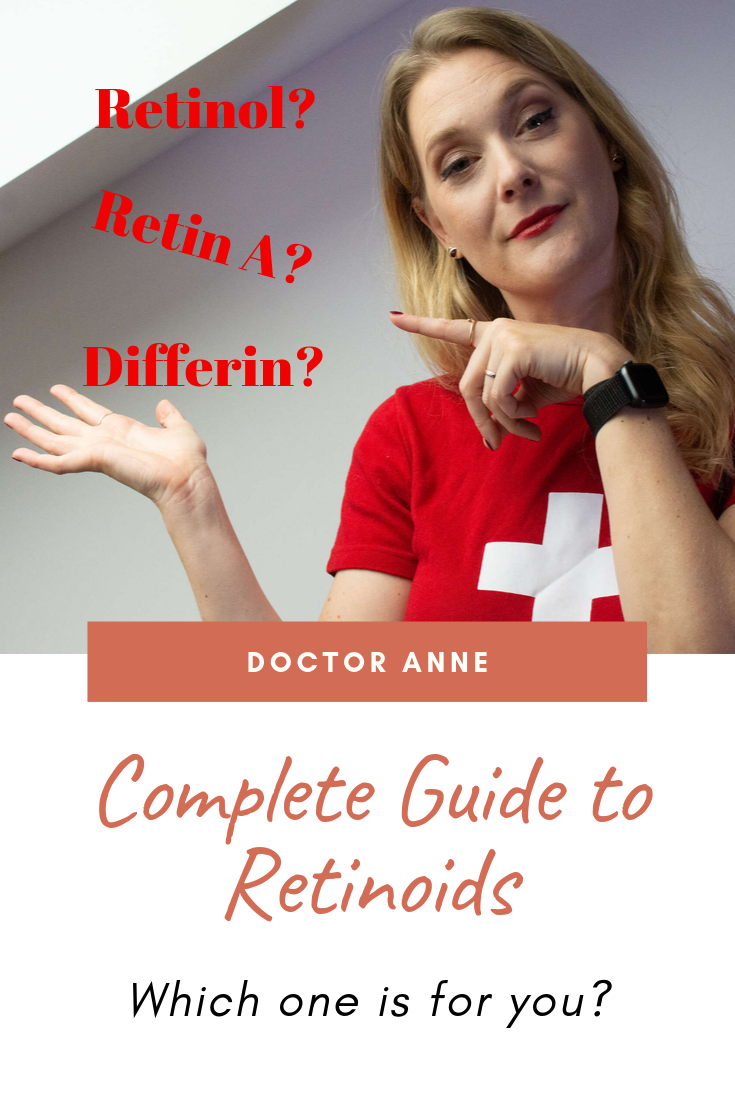Retinol vs retinoid – not as confusing as you think
Skincare is confusing, I get that. It is hard to figure out which products you need, even harder to identify the ingredients that will help you, and if these ingredients then go by a bazillion different names, it seems like an impossible task to make sense of it.
So to help you figure out the Retinol vs retinoid thing and help you pick the right ingredient for your skins problems, here is a handy little guide to the different types of retinol.

Retinol vs retinoid – What is the difference?
Technically speaking, retinol is a substance and retinoid is a family. Or: Retinol is a retinoid, but retinoid means much more than just retinol.
Retinoids are: Retinoic Acid, Retinaldehyde, Retinol, Retinyl Palmitate and then a few other substances like Adapalene, Bakuchiol or Hydroxypinacolone Retinoate.
Retinoic Acid is the „mother“ of all retinoids, the active form and the one that has the most research behind it.
Sadly companies use the term „Retinol“ to refer to retinoids when they name their products, so to be sure you need to read the ingredient list (I teach you how to do it here).
And on a side note: All retinoids are man made and therefor vegan, so don’t fall for the „vegan retinol“ claim. The product formula might not be, but the retinoid is vegan anyway. But: Most retinoids have at one point in history been tested on animals – not anymore, but depending on how you define „cruelty free“ that might be worth noting.
How does Retinoic Acid work?
Retinoic Acid is available both orally and topically, and has been used to treat acne for decades now.
It binds to three specific receptors (receptors are tiny structures outside the cell membrane) and initiates different processes that stimulate cell turnover and increase collagen production, which basically means that it increases the speed at which new cells are build.
The benefits of Retinoic Acid:
- Reduces the depth of wrinkles
- Fades hyperpigmentation
- Exfoliates the skin
- Thickens the skin
- Tightens the skin
- Reduces early precancerous lesions
This means Retinoic Acid has anti aging and anti acne benefits!
Please note: These are the benefits of Retinoic Acid, not all retinoids have the same effect!
The downsides of Retinoic Acid:
- Flaking skin
- Irritated skin
- Dry skin
- Sensitive skin
Again: Not all retinoids have these side effects, but as they are caused by the way Retinoic Acid works (increased cell turnover), the ones that have similar benefits tend to have similar side effects.
Your skin can get accustomed to Retinoids though, so with proper introduction you will be able to minimize these effects.
Retinoic Acid is available as prescription only and I would highly recommend you DO NOT try and get it somewhere without seeing a professional!

How about Retinaldehyde, Retinol and Retinyl Palmitate?
All three will be converted into Retinoic Acid once absorbed into the skin, and the main difference is the number of conversion steps needed before they reach the „active form“ (aka the form that binds to the receptor and triggers the effects).
With each conversion step, the efficacy decreases, so you need about 20 times as much retinol (two conversion steps) as you would need Retinoic Acid to get the same effect.
These are available over the counter and are the ones that you will most often see in your cosmetic products.
Retinaldehyde (Retinal)
This is one that I rarely see in formulas, probably because out of the three mentioned it is the most potent one (It only needs one conversion step to reach active form)
Which means you are more likely to see visible effects, but also have the highest risk of developing side effects if not careful.
An effective concentration seems to be 0,05% to 0,1%
Retinol
The most common one, probably because it hits the sweet spot of delivering noticeable results (when used in the right concentration), but at the same time has a lower risk for irritation than Retinaldehyde.
It needs two conversion steps to reach active form.
Concentrations range from 0,01% up to 1% (which is about similar to 0,05% Retinoic Acid, so pretty strong)
Retinyl Palmitate
This is the weakest one (it needs three conversion steps to reach active form) and many experts doubt that it has any retinoid effect on the skin in the concentrations it is used in skincare.
I have used it without any noticeable effects, but if your skin is very sensitive, it might be one that you want to try.
Adapalene (Differin)
This one has become increasingly popular over the last year, because it is now available over the counter in the US. It is no direct descendant to Retinoic Acid, but binds on two out of the three receptors Retinoic Acid binds to.
It also seems to have less side effects than Retinoic Acid.
But before you rush out and buy it: So far we have good data that it has anti acne effects, but we don’t know for sure about the anti aging effects.
If you are in your early 20s and struggle with acne I would go for Adapalene, but if you are after the anti aging effect, I would go for either Tretinoin or Retinol (or Retinal) instead.
Hydroxypinacolone Retinoate
This one is a Retinoic Acid-Ester (NOT a Retinol-Ester!), and it supposedly does not need any conversion steps, but can, similar to Adapalene, bind directly to two of the three receptors.
So far we have a few studies that find less side effects with good results, but it is worth noting that all these studies were performed by the manufacturer and their design wasn´t overly convincing for me.
That doesn’t mean Hydroxipinacolone Retinoate isn’t a good product, it just means that I think we need more (and independent) research to be sure where we stand in comparison to Retinol or Retinoic Acid.
You will sometimes find this one under „Granactive Retinoid“, which is a mixture of Hydroxypinacolone Retinoate and Dimethyl Isosorbide, so most likely acts a little different than the pure form of Hydroxypinacolone Retinoate.
The Ordinary have a few products that use this form of retinoid.
RetiStar® Retinol
Again a form of Retinol, sometimes referred to as „encapsulated Retinol“ that is not pure, but a mixture of Retinol, Vitamin E, Castor Oil and Caprylic Triglycerides which supposedly stabilize the retinol molecule.
It is hard to tell which concentration of Retinol you will actually get when this is used in your products and there is limited data if the „encapsulation“ hinders the release and conversion process in any form.
Retinyl Retinoate
Another interesting one, because it is basically a Retinol molecule linked to a Retinoic Acid molecule. The thought behind that once it is absorbed into the skin, it is broken down into Retinoic Acid that delivers an immediate effect and into Retinol, which is slowly converted into Retinoic Acid and starts to work later.
Companies sometimes refer to that as „time released Retinol“, but that term is used for encapsulated Retinol versions as well.
Again, interesting concept, little data.
Bakuchiol
Bakuchiol was the Buzzword in 2019, and the one most commonly referred to as „vegan Retinol“ or „plant-based Retinol“.
I already did a whole blog post on Bakuchiol here, so I will keep it short:
It is an interesting substance that seems to be as effective as Retinol, but with lesser side effects. We don’t have much data though, and certainly not enough data to claim that it has „zero irritation“ or is „stronger than Retinol“, all of which I have seen.
The only thing we know for sure is that it is less sensitive to UV exposure and can be worn throughout the day. Which, if you ask me, all retinoids can as long as you wear your SPF.
So if you are very sensitive to Retinol side effects, it is a great one to try if otherwise you wouldn’t be able to use a Retinoid at all, but not the be all end all.
I know that this has been a lot of theoretical information, but I really wanted you to understand the whole Retinol vs Retinoids debate and be able to identify what actually is in the product you are contemplating buying.
If you want some tips on how to incorporate retinoids into your skincare routine with minimal risk of irritation – I will do a blog post on that soon.



